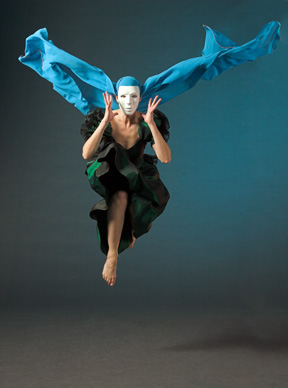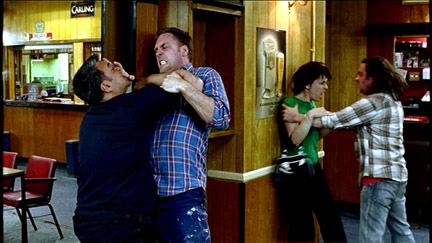San Francisco Letter No. 9
Company Chaddick
“Landslide”
Danzhaus, San Francisco
May 19, 2006
Ballet San Jose Silicon Valley School
Annual Showcase
California Theatre, San Jose
May 21, 2006
Rosas Dance Company/Ictus Music Ensemble
Dance Film “Counter Phrases”
Yerba Buena Center for the Arts
May 23, 2006
by Rita Felciano
copyright ©2006, Rita Felciano
 One advantage of artistic survival — let’s say 21 years — is that the artist has the opportunity to refine her choreographic technique and develop a personal signature. The disadvantage, unless you have grown to real prominence, is that audiences take you for granted. You are a known quantity, and you can no longer promise the thrill of discovery or the spice of surprise. Such is the case for Cheryl Chaddick who every year — since 1985 — has offered a season of new and reprised repertory.
One advantage of artistic survival — let’s say 21 years — is that the artist has the opportunity to refine her choreographic technique and develop a personal signature. The disadvantage, unless you have grown to real prominence, is that audiences take you for granted. You are a known quantity, and you can no longer promise the thrill of discovery or the spice of surprise. Such is the case for Cheryl Chaddick who every year — since 1985 — has offered a season of new and reprised repertory.
Chaddick’s work is so refreshing because it embraces structure without making a fetish out of it. Hers are “well-made” dances which explore passions and desires, spiritual quests and work situations; they are intelligently choreographed, flow naturally and are performed by dancers who know exactly what they are doing. If that evokes echoes of Graham and Limon, so be it. She studied both techniques for many years. Chaddick also has a sometimes delicious, sometimes a little simple minded sense of humor. In other words, she has a voice of her own.
And yet “Landslide” was a discovery and a surprise: a full-evening, site-specific work, more imagistic than through composed. She has done very few of those. For this newest venture, Chaddick moved her 9-member company into San Francisco’s warehouse district, into a small, little known venue, Danzhaus, which has been carved out of a former T-shirt factory. The piece moved around the building’s little nooks and crannies to what looked like a bar adjacent to a multi-purpose room and an overhanging balcony. At one point, the action also moved upstairs into a modern dance studio.
The premise for “Landslide”, as explained in the program notes, was Chaddick’s desire to explore interior landscapes. “We are like icebergs,” she said, “seeing only about a tenth of what is really there, the rest is hidden under water.” What I saw was a series of fairly unrelated vignettes that straddled the edge between reality and phantasmagoria. In the finale for which the assembled dancers shed and donned white masks during a lovely sequence of shared moves and gestures, one got a sense that a journey of discovery had taken place. Still, this was a piece in which individual scenes had to make their own point, without necessarily contributing towards a connective tissue.
In Chaddick’s hands, Danzhaus became a fun house full of ghosts. A man and a woman in the same trousers, screamed, wrestled and howled. Two women in Victorian gowns beat themselves against an upstairs window. Mysterious bulbous clown figures crowded a narrow staircase. Three closeted women, in red ball gowns, preened, posed and hissed like locked up cats. But the best, and most dancey choreography became alive in simple black working outfits. That’s when Chaddick’s ability for fluid phrasing and full-bodied engagement shone. In the “bar” they used the banquets, stools and the counter in wave after wave of diving, popping up, rolling or simple sitting like evocations of earlier patrons. A male trio upstairs engaged in a introspective game of copying and gesturing. The finale dragged on for much too long but its sense of life as hovering between the visible and the hidden worked.
A Sunday afternoon trip to San Jose offered two pleasant surprises. One of them was a first time visit to the California Theatre, an 1,100 seat 1927 movie/vaudeville house, recently gloriously restored into its pseudo-oriental elegance with touches of art deco thanks, in part, to the munificence of Silicon Valley entrepreneur and arts patron David Packard. The building, because of years of neglect, apparently barely escaped the wreckers’ ball when, just in time, a prince arrived to save this beauty.
 The other surprise related to the result of the training that the 360+ students receive at the company’s ballet school, directed by Lise La Cour, former Royal Danish Ballet dancer and choreographer. I wondered whether her extensive Bournonville training would be reflected in the kind of students the school is developing. The answer is both yes and no. What the students did show in both La Cour’s “Little Mermaid” and the Pas de Six and the Tarantella from “Napoli, Act III” is a refined approach to dancing that stressed expressivity over bravura. Even among the weaker performers in “Mermaid” and “Napoli,” there wasn’t a stiffly self-conscious one, pushing at the surface of technique. Some of the girls had lovely upper body fluidity. What they couldn’t manage was the speed and the precision of the footwork. (Most of the male roles were performed by apprentices or company members.)
The other surprise related to the result of the training that the 360+ students receive at the company’s ballet school, directed by Lise La Cour, former Royal Danish Ballet dancer and choreographer. I wondered whether her extensive Bournonville training would be reflected in the kind of students the school is developing. The answer is both yes and no. What the students did show in both La Cour’s “Little Mermaid” and the Pas de Six and the Tarantella from “Napoli, Act III” is a refined approach to dancing that stressed expressivity over bravura. Even among the weaker performers in “Mermaid” and “Napoli,” there wasn’t a stiffly self-conscious one, pushing at the surface of technique. Some of the girls had lovely upper body fluidity. What they couldn’t manage was the speed and the precision of the footwork. (Most of the male roles were performed by apprentices or company members.)
The contrast between the fluidity in “Mermaid” and “Napoli” and the stiffly performed, externally motivated modern piece, “Choices”, a jazz-influenced trifle by Jodi Porter, was striking.
La Cour’s 1989 charming “The Little Mermaid”, one of four children’s ballets she choreographed for the young RDB dancers, was so heavily Bournonville-inspired that it made me want to hop on the next plane to go back to Copenhagen. Even the minor roles — gaping fishes, wafting flowers, slimy witch attendants — were nicely individualized. The mime, of which there was quite bit and remarkably well done, probably was lost on most of the audience, and the ballet, of course, had a difficult time to overcome the inherent handicap of having a heroine dancing with and without legs. My suspicion is that, perhaps, the ballet was originally performed by more advanced dancers, and that the choreography — some of it looked a little thin — maybe have had to be modified.
There were wonderful Bournonville touches. Exotic belly-dancers (on point) contrasted with robustly polkaing sailors and deck hands. A young attendant mimicked every princely move. The choreography beautifully set up the contrasting worlds of the lovely sea and the lovely earth maidens. Pretty Danielle Dunmire’s delicate trajectory from innocence to “salvation” through suffering was quite convincing. With colorful costumes and sets by Bjorn Wiinblad and music by Ben Fabricius-Bjerre, this was a rich production which (almost) compensated for some of the short comings in the choreography. The frontice piece projected a silhouette of Hans Christian Anderson at his writing desk, surrounded by stack and stacks of books that spilled out onto the stage.
While Napoli Act III didn’t reveal any outstanding dancers, its modest success resided in the projected sense of community of this “national anthem for the Danes”. Even these young, American dancers understood the concept that life on the side sidelines — watching, commenting, participating — has value and is making a contribution.
 Throughout the season Charlotte Shoemaker, curator for San Francisco Performances’ Dance Screen series, programs dance on film in conjunction with SFP’s roster of visiting artists. Once a year she also puts together, “Innovative International Dance Films,” an evening of choreography for the screen. The most recent offered a masterpiece, “Counter Phrases”, the hour-long collaboration between choreographer Anne Teresa de Keersmaker and her longtime musical partner and film artist Thierry de Mey.
Throughout the season Charlotte Shoemaker, curator for San Francisco Performances’ Dance Screen series, programs dance on film in conjunction with SFP’s roster of visiting artists. Once a year she also puts together, “Innovative International Dance Films,” an evening of choreography for the screen. The most recent offered a masterpiece, “Counter Phrases”, the hour-long collaboration between choreographer Anne Teresa de Keersmaker and her longtime musical partner and film artist Thierry de Mey.
De Mey had the stunningly articulate Rosas dancers perform 14 fragments from de Keersmaker’s “(But if a look should) April Me” and filmed them — with three cameras — in exquisite outdoor environments—private estates, public gardens, a city plaza, a lake, a wood of young trees. Ten composers were then commissioned to write a score after having viewed their assigned sections. (Four are danced to silence)
Originally, the finished product was projected on three overhead screens, with the music being performed live underneath by the Ictus Ensemble. The result must have been stunning. But even under the present circumstances, “Counter Phrases” wove a spell of formal elegance that was impossible to resist. The triptych’s format allowed for multiple perspectives of each gesture. It also moved the dance phrases back and forth horizontally across the screens and created ever shifting depths of field. The brilliant editing of these sometimes exceptionally color-saturated images — to the point of approaching abstraction — added a wonderful rhythmic complexity to the inherent rhythm of de Keersmaker own phrases. Layered on top of that were musical responses by Steve Reich and excellent European composers.
Some of “Counter Phrases” sections had a surrealistic quality to them; other recalled the visual arts—Fauvists, Monet, Rousseau. One of them could have been a child’s dream in a flower-filled garden. In Reich’s ‘Dance Patterns’, performed on an urban plaza, the music came in almost as an afterthought while Robin de Raaf’s ‘Orphic Descent’ followed a dancer racing down enormous moss-covered stairs, flanked by huge blue cypresses. ‘Moving Trees’, a “now you see me, now you don’t section”, featured very delicate music by Jonathan Harvey. De Mey’s ‘Water’ seemed to be all about balance.
The three shorts which preceded “Counter Phrases” couldn’t compete but each offered a intriguing perspective on how film and dance can support each other. Head shots may have never looked better than in Viktoria Marks’ “Touch” in which four very different couples execute a series of facial touches. Its sense of intimacy invaded became almost unbearable, making us, as one audience member observed, voyeurs.
The hilarious "Fisticuffs", a British film by Miranda Pennell, is set in a proper British bar and juxtaposes proper English ladies with bar room brawls as perfected by Wild West movies.
"Arcus", a black and white short with a finely honed trajectory by film makers Alla Kovgan and Jeff Silva and choreographer Nicola Hawkins, starts with actual dancers who disappear into abstracted images. As Shoemaker succinctly summarized the work, “you lose the dancers but you don’t lose the dance.”
Photos:
First: Lise Worthen. Photo by Marty Sohl.
Second: Danielle Dunmire as The Little Mermaid and Robert Raney at The Prince. Photo by Robert Shomler.
Third: "Fisticuffs" by director Miranda Pennell.
Volume 4, No. 21
May 29, 2006
copyright ©2006 Rita Felciano
www.danceviewtimes.com